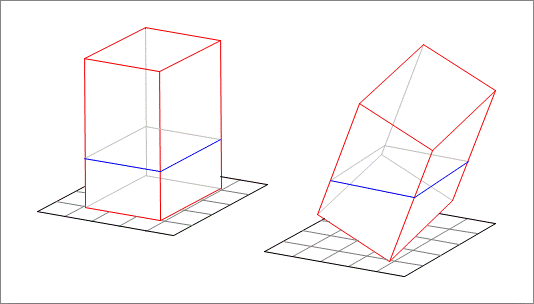Tilted cuboid tank - 1

A cuboid tank is placed on the plane, with its base centered at the origin. The base rectangle edges measure along the axis and along the axis. The height is . It is filled to of its height with water. This is shown on the left of the above figure. Then, it is tilted by about an axis of rotation passing through the base vertex , and parallel to the vector . This is shown on the right of the above figure. Find the new height of the water surface relative to the plane. If this new height is , enter .
The answer is 45556.
This section requires Javascript.
You are seeing this because something didn't load right. We suggest you, (a) try
refreshing the page, (b) enabling javascript if it is disabled on your browser and,
finally, (c)
loading the
non-javascript version of this page
. We're sorry about the hassle.
From symmetry, it follows that the water surface after tilting must pass through the point ( 0 , 0 , 3 ) (coordinates in the tilted frame of reference attached to the cuboid). Thus, all we have to do is rotate the vector v = ( 0 , 0 , 3 ) − ( 2 5 , − 2 7 , 0 ) = ( − 2 5 , 2 7 , 3 ) about the given axis, and then take its z -coordinate. The perpendicular unit vectors to the axis are ( − sin 6 0 ∘ , cos 6 0 ∘ , 0 ) and ( 0 , 0 , 1 ). The components of v along u 1 and u 2 are x = v ⋅ u 1 = 4 1 ( 5 3 + 7 ) , and y = v ⋅ u 2 = 3 . Hence the rotated vector v ′ = ( x cos 3 0 ∘ − y sin 3 0 ∘ ) u 1 + ( x sin 3 0 ∘ + y cos 3 0 ∘ ) u 2 . Performing these calculations, results in,
v ′ = ( − 1 . 6 3 7 2 5 9 5 2 6 , 0 . 9 4 5 2 7 2 2 2 8 , 4 . 5 5 5 6 0 7 9 6 6 )
Hence, the water level is 4 . 5 5 5 6 0 7 9 6 6 , and this makes the answer ⌊ 4 5 5 5 6 . 0 7 9 6 6 ⌋ = 4 5 5 5 6